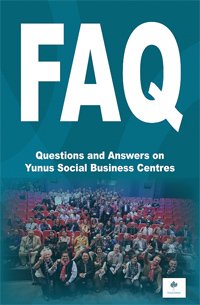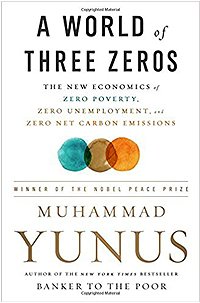An Interview of Muhammad Yunus with Harvard Business Review, December 2012
Life's Work: Muhammad Yunus
An Interview with Muhammad Yunus by Alison Beard
Â
Muhammad Yunus won a Nobel Peace Prize for spreading the concept of microcredit—tiny loans to help poor people start businesses—via his Bangladesh-based Grameen Bank. He resigned as CEO of that organization last year, at age 70, due to pressure from the Bangladeshi government, but he remains active in Grameen ventures elsewhere in the world. Interviewed by Alison Beard
HBR: There was a lot of controversy over your retirement. It was reported that the Bangladeshi government, which owns 3% of Grameen Bank, forced your hand. Yunus: Look, when I was 60, I submitted my resignation. “Why do you want to retire?†the board asked. “Is the work becoming too heavy on you? Do you want to do something else? If you’re enjoying your work and we enjoy you, why don’t you continue?†So I said OK. When I turned 70, I did the same thing. I said, “I think I should go.†They said, “You cannot.†Staff members all over the country were writing me letters saying, “Don’t leave. This will bring a panic.†So again I couldn’t leave. But I wrote a letter by my own hand and took it to the finance minister and said, “I’m trying to retire as CEO, so why doesn’t the government appoint me as chairman? This way I can continue in a nonexecutive position and the position of CEO can go to a new person, without disrupting the whole motion of the bank.†Then last year the [government] authority asked for my resignation, saying I was illegally holding on to the position of CEO; I should have retired 10 years before at the age mandated by government bank rules. I contested in the high court, but the court did not accept my case. So I resigned.
Yunus: Look, when I was 60, I submitted my resignation. “Why do you want to retire?†the board asked. “Is the work becoming too heavy on you? Do you want to do something else? If you’re enjoying your work and we enjoy you, why don’t you continue?†So I said OK. When I turned 70, I did the same thing. I said, “I think I should go.†They said, “You cannot.†Staff members all over the country were writing me letters saying, “Don’t leave. This will bring a panic.†So again I couldn’t leave. But I wrote a letter by my own hand and took it to the finance minister and said, “I’m trying to retire as CEO, so why doesn’t the government appoint me as chairman? This way I can continue in a nonexecutive position and the position of CEO can go to a new person, without disrupting the whole motion of the bank.†Then last year the [government] authority asked for my resignation, saying I was illegally holding on to the position of CEO; I should have retired 10 years before at the age mandated by government bank rules. I contested in the high court, but the court did not accept my case. So I resigned.
But my personal position is not important. The important thing is to protect the rights of the women who own 97% of the shares of this bank. The law gives them the right to hire and fire the CEO and decide the age and the terms of his appointment. This is an organization that serves 8.3 million families; that’s around 40 million people—a quarter of the population of Bangladesh. It is run very well, and it won the Nobel Peace Prize. I just want to see that success continue.
But isn’t it in jeopardy now since the government is investigating Grameen Bank and seems to desire more control over its leadership? For example, its own political appointee, the bank chairman, will now appoint a selection committee to decide on your successor rather than the elected board. How do you feel about that?
It has fundamentally damaged the very essence of Grameen Bank. With this change, the government has practically taken over management, and this will set in motion the end of the bank. This is a disaster. A self-governing entity that has empowered poor women and earned global admiration will now be converted into a poorly managed and corrupt government bank. What a tragic end.
Do you regret staying on so long and not grooming any obvious successors?
No. There is no reason to regret. Grameen Bank is a hierarchical company. There’s a managing director—that is, a CEO—and the deputy CEO, and the general manager. Since I left the bank 15 months ago, two new acting CEOs have been in the top job, and the government has made frequent comments that the bank is managed better now than before. It seems I groomed not only one able successor but a line of them. The government says it will do an international search to recruit the new CEO, but it would be shameful for a Nobel-winning organization born from the initiative of a local person, institutionalized by local staff, operating only within the borders of one country to have a CEO who might not have roots in Bangladesh and who might not communicate well with the bank owners. Would such a person be a better successor than the ones I left behind?
Microfinance has also come under fire in recent years. How do you maintain quality control as your organization and your ideas spread?
The problem is not microcredit. It’s using the idea for the wrong purposes. Some programs in India treated microcredit as an opportunity to make money. They blew it up and went to the stock market to float IPOs and so on. And that created all the tension. Now in some places even the loan sharks call their services microcredit. But we have no problem at Grameen Bank in Bangladesh, because microcredit has remained mission-driven. We want to help poor people. We don’t see them as an object for making money.
How do you make sure all your people are adhering to the mission?
We have 2,600 branches at Grameen Bank. Each one is almost autonomous. But our goals are very clearly stated, and we monitor whether the branches are meeting them through something called Five Star. Each employee is supposed to look after 600 borrowers. If you get 100% repayment from those borrowers, you get a star. If the whole branch achieves 100%, then everyone in the branch gets a star. If you do it for the whole year, you get another star. If your branch is profitable, you get a fourth star. And if the children of the borrowers in your branch are all in school—every single child—you get the fifth star. These are stars you can wear on your chest, like in the military. So you go to work, and you see the star achievement.
What qualities do you look for in Grameen employees?
In the beginning, we were very small, so we were picky. We were trying to get the best possible staff. Now that we’re hiring so many people, we’re not looking for the ideal. There will be qualitative differences in the people we hire, but it’s OK. Bring them in, and let them go through the process. We take many kinds of people, and the system turns them into ideal people.
Grameen Bank started out as a field research project. Why is getting out into the field so important?
When I was doing my PhD and then teaching, I developed a bird’s-eye view. I could see a very wide spectrum of things, almost the whole world. But I was seeing only the outline of things and filling them in, like a child coloring in a box, by making up stories about how people behave. Then, working in the village, door-to-door, person-to-person, I got a worm’s-eye view. I saw things at very close range—all the details, what really happens inside. And that’s more important, because I could then clearly see what the problem was and try to solve it—to start with a tiny little problem, and feel energized by it.
How do you zoom out again?
I don’t. I look just at one plot, not the whole plantation. I do the plot and it works, so I do the next plot the same way. You start with 100 people and then move to the next 100 people, and eventually you see you can simultaneously add 100 people here, another 100 people there and there. You’re adding up to a bigger scale at a gradual speed. Then you have to monitor and start linking the structure and so on. But you’re not designing at the outset for a million people, starting with a megastructure. You’re moving step by step.
Still, you’re also known for setting huge goals. Why do you do that?
I believe that if you put all the creative power of human beings on one side and all the problems of the world on the other, and put them into a battle, human creative power will always win. It’s just that we don’t use our creative power to address problems; we use it to make money. We have created a system of money-chasing entities, rather than problem-solving entities. So how do we break from this? Social business. Create companies that are devoted to solving a tiny slice of our problems and that operate with the efficiency of business—but whose investors don’t expect any dividend. Making money is a happiness. Making other people happy is also a happiness. So why don’t we do both and maximize our happiness?
Should every company be a social business, or have a part of it that’s a social business?
Every company is a legal personality, so just as every person can do both, every company can do both. It’s a choice, whether it’s exclusively one or the other, or mixed in various proportions: 80/20 or 20/80. I’m not opposed to money-making. But why don’t you create a tiny little social business on the side to take five people out of the welfare system, or provide health care or technology to a group without it, or create a business to employ juvenile delinquents? Whatever you feel comfortable with.
In the joint ventures you’ve done with big corporations, what are some of the obstacles you’ve faced?
I have more excitements than problems. But there was one interesting problem with Danone that became a classic case. We had a 50-50 joint venture agreement: Grameen would give €500,000, and so would Danone. Grameen had no problem. But Danone couldn’t provide its half. Weeks went by, and they could not. Months went by; they could not. Finally, they explained. Their lawyers were objecting, saying that the money belonged to the shareholders and therefore couldn’t be used to invest in a company that would not pay them a dividend. But then Danone came up with a solution. It sent out a letter to all the shareholders before the annual general meeting saying: We want to start a company in Bangladesh that will tackle the problem of malnourished children. If you want to use part of your dividend to invest in this company, please sign up and tell us what percentage you want to put in. Around 97% or 98% of the shareholders signed up, and Danone ended up with €35 million. So there was a problem, and there was a solution.
How hands-on is your role in Grameen’s joint ventures?
I’m only one person. Most of the time, I’m not contributing personally in the design of the products. But I’m a catalyst for bringing people together, focusing on objectives, reminding everyone what we want. For example, in the Danone case, they first showed me a plastic container for yogurt. I said, “In social business, plastic is not allowed. We want biodegradable material.†The Danone guys said, “We use plastic all over the world.†And I said, “All over the world you’re a profit maker. Here you’re a social business.†They were unhappy, but they started looking for a solution. After four months, they came back with a new container made of cornstarch. “Can I eat it?†I asked. “Because why should poor people spend money on something they have to throw away? Why can’t you put nutrition in the cup?†So they worked very hard to make an edible cup. These big companies have enormous creative power. But unless you ask, you’ll never get an answer.
You have such a wide network of supporters. How do you go about building those relationships and lobbying for your ideas?
I don’t lobby for support. People become supporters because it matches their own wishes and desires to help the poor.
Fully 97% of Grameen’s loans are to women. Are women better businesspeople than men?
Women used to hold less than 1% of bank loans in Bangladesh. So when I created Grameen, I wanted to make sure that half of the borrowers were women. When we approached them, they said, “I don’t know what to do with money. I’m afraid of money. Give it to my husband.†And I thought, “This is not the voice of the woman. This is the voice of history, of the system, which created fear in their minds.†It took us six years to finally achieve the goal of 50/50. Then we saw that the women borrowers brought so much more benefit to their families. Women want to build up something for the future with their money. Men want to spend it enjoying themselves. So we changed our policy to focus on women.
Grameen works across the world now. What cultural differences have you seen?
We have a bank in New York City now—9,000 borrowers, an average loan of $1,500, repayment rate over 99%—and it’s doing exactly the same things we do in Bangladesh. There is no cultural variation. We focus on what Grameen is: tiny loans to poor women.
Do you think you’ll ever fully retire?
I don’t think any human being wants to retire as long as they enjoy the life. And I’m enjoying the life.
Â
Source: Harvard Business Review
Publication date: Dec 01, 2012. Prod. #: R1212M-PDF-ENG


